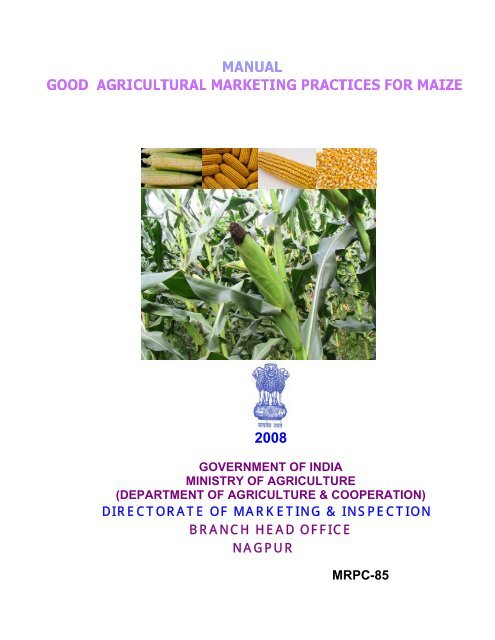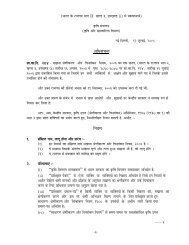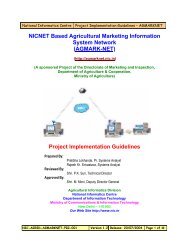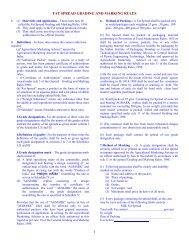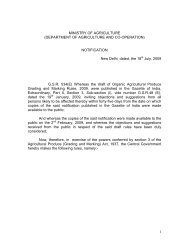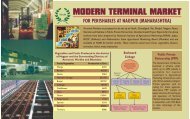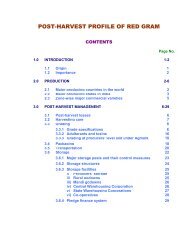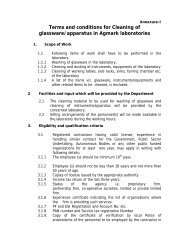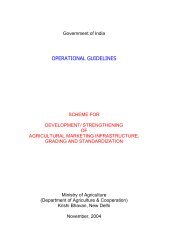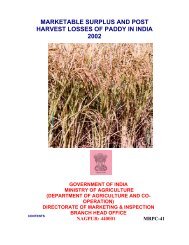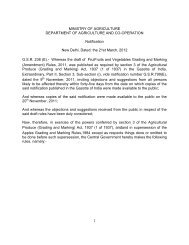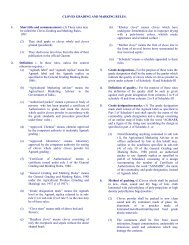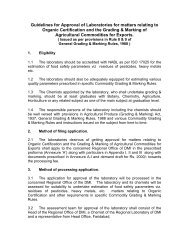directorate of marketing & inspection branch head office ... - Agmarknet
directorate of marketing & inspection branch head office ... - Agmarknet
directorate of marketing & inspection branch head office ... - Agmarknet
You also want an ePaper? Increase the reach of your titles
YUMPU automatically turns print PDFs into web optimized ePapers that Google loves.
2008<br />
GOVERNMENT OF INDIA<br />
MINISTRY OF AGRICULTURE<br />
(DEPARTMENT OF AGRICULTURE & COOPERATION)<br />
DIRECTORATE OF MARKETING & INSPECTION<br />
BRANCH HEAD OFFICE<br />
NAGPUR<br />
MRPC-85
PREFACE<br />
Maize is an important crop in our country and world. It is utilized as food,<br />
feed and fodder. It is used at different stages <strong>of</strong> it’s growth and has several<br />
industrial uses. It is the major source <strong>of</strong> starch (71 to 72 percent). Rajasthan,<br />
Uttar Pradesh, Madhya Pradesh, Bihar, Karnataka, Gujarat and Andhra Pradesh<br />
are the major maize producing states.<br />
The Inter-Ministerial Task Force on Agricultural Marketing Reforms in their<br />
report in May,2002, suggested several measures for undertaking various reforms<br />
in the Agricultural Marketing System in the country. In view <strong>of</strong> the keen competition<br />
in the domestic as well as international markets, it has become imperative to<br />
launch awareness programmes vigorously to up-date the technical know-how <strong>of</strong><br />
various stakeholders involved in the <strong>marketing</strong> <strong>of</strong> farm produce in multi<br />
dimensional aspects <strong>of</strong> agricultural <strong>marketing</strong> system.<br />
In view <strong>of</strong> the above, an attempt has been made to draft a “Manual on<br />
Good Agricultural Marketing Practices for Maize”. This manual covers various<br />
aspects <strong>of</strong> post harvest management and <strong>marketing</strong> <strong>of</strong> maize.<br />
This “Manual on Good Agricultural Marketing Practices for Maize” has been<br />
prepared by Shri MANOJ KUMAR, Marketing Officer under the supervision <strong>of</strong><br />
Shri P.G. CHOUDHARI, Senior Marketing Officer and overall guidance <strong>of</strong><br />
Shri P.J. CHIMALWAR, Asstt. Agricultural Marketing Adviser, D.M.I. B.H.O.,<br />
Nagpur.<br />
The Directorate <strong>of</strong> Marketing & Inspection acknowledges the assistance<br />
and co-operation extended by various institutions/organisations in supplying the<br />
relevant data/information required for compilation <strong>of</strong> this manual.<br />
The Govt. <strong>of</strong> India should not be regarded as assuming responsibility for<br />
any <strong>of</strong> the statements contained in this manual.<br />
--Sd--<br />
(U.K.S. Chauhan)<br />
Faridabad<br />
Agricultural Marketing Adviser<br />
Dated : 18.03.08 to the Government <strong>of</strong> India
GOOD AGRICULTURAL MARKETING PRACTICES FOR MAIZE<br />
CONTENTS<br />
PAGE NO.<br />
1) INTRODUCTION 1<br />
2) NUTRITIONAL VALUE 1<br />
3) IMPORTANT VARIETIES GROWN IN INDIA 2<br />
4) HARVESTING AND POST- HARVEST CARE 3<br />
5) GRADING 4<br />
6) PACKAGING 5<br />
7) TRANSPORTATION 6<br />
8) STORAGE 7<br />
9) IMPORTANT ASSEMBLING MARKETS 13<br />
10) MARKETING CHANNELS 14<br />
11) MARKET INFORMATION AND EXTENSION 15<br />
12) ALTERNATIVE SYSTEM OF MARKETING 16<br />
13) INSTITUTIONAL CREDIT FACILITIES 18<br />
14) ORGANISATIONS PROVIDING MARKETING SERVICES 20<br />
15) DO’S & DON’TS 22<br />
ANNEXURES<br />
ANNEXURE – I : AGMARK GRADE SPECIFICATION OF MAIZE 23<br />
ANNEXURE –II : FCI UNIFORM SPECIFICATION FOR MAIZE 24<br />
ANNEXURE – III : CODEX STANDARDS FOR MAIZE (CORN) 25
MAIZE<br />
Botanical Name: Zea mays<br />
Family: Gramineae<br />
1.0 INTRODUCTION:<br />
M<br />
aize is widely cultivated throughout the world. It is an important<br />
cereal crop in India. United States <strong>of</strong> America, China, Brazil<br />
France, Indonesia, India and South Africa are the major maize growing<br />
countries in the world. The importance <strong>of</strong> maize is due to it’s wide<br />
diversity <strong>of</strong> uses. It is used both as food for human and feed for<br />
animals. In the United States and Canada, the primary use for maize is<br />
as a feed for livestock. Green cobs are roasted and eaten by people<br />
with great interest. Corn is converted in to a variety <strong>of</strong> foods such as<br />
popcorn, sweet corn, flour and staple alkali-cooked foods. The starch,<br />
the major constituent <strong>of</strong> the corn kernel is used in foods and many<br />
industrial products, including transformation into plastics and fabrics..<br />
The starch is also converted into glucose or fructose for use as food sweetness. It is also<br />
fermented and distilled to produce grain alcohol. Increasingly, ethanol is being used as an<br />
additive in gasoline for motor fuels to lower pollutants, and reduce petroleum use, which is<br />
nowadays also known as bi<strong>of</strong>uels.<br />
2.0 NUTRITIONAL VALUE:<br />
Content<br />
Percentage dry matter basis<br />
Starch 71 - 72<br />
Proterin 9 - 10<br />
Fat 4 - 45<br />
Fiber 9 - 10<br />
Sugar 2 - 3<br />
Minerals (ash) 1.4<br />
1
3.0 IMPORTANT VARIETIES GROWN IN INDIA:<br />
Important varieties grown in various States<br />
Sl. No. State Varieties<br />
1 Andhra Pradesh Ashwini, Harsha, DHM-15, Varun, DHM-103, Trashulata,<br />
Amber, Popocorn, Madhuri.<br />
2. Assam Vijay, Navjot, NLD, Kishan, Ganga-5, Rajendra, Macca-1.<br />
3. Bihar Vijay composite, Ganga white-2, Ganga-5, Rajenndra HYV,<br />
Diyara Composite<br />
4. Gujarat Gujarat Maize-1, Gujarat Maize-2, Gujarat Maize-3, Gujaratsafed-2,<br />
Ageti-6, Ganga-5.<br />
5. Himachal Pradesh Early Composite, Paravati, Naveen Composite, Him 123,<br />
Sartaj, Popcorn.<br />
6. Jammu & Kashmir Maize GS-2, HIM 123, Apna Makka, Pioneer Series, Kanchan<br />
series, Navjot, Mansor, C-6, C-8, C-15.<br />
7. Karnataka Agsun-126, AP-407, AB 2001-2002,Deccan 103, CMH-6644,<br />
Ganga –11, MMH 3816, VMH-108, Laxmi-4950, Vijay, INH-<br />
666, Kanaka, Swarna, VMH-869, G.K.Series, MH Series,<br />
VMH Series, Kaveri Series, Pioner.<br />
8. Madhya Pradesh Ganga (White)-2, Ganga 5 & 11, Macca-101, 103.<br />
M.D.II, M-103&105, Chandan M-3, Navjot, Pusha 2, Mopset,<br />
Surya-11, Jawahar Maize-81<br />
9. Maharashtra MSSC-1100<br />
10. Orissa Bijay, Ganga-1, Ganga-5, Ganga-101,Kishan,Vikaram.<br />
11. Punjab F-9572-A,Paras,Prabhat,Kesari,Punjab Sathi.<br />
12. Tamil Nadu K1, K2, Col, COH-I, COH-2 ,COH(M)4, Ganga-5, DECCAN,<br />
COBC1.<br />
13. Uttar Pradesh Ganga-2, Ganga-11, Tarun, Naveen, Kanchan, Sweta, D-765,<br />
Surya, Azad, Utlam, Nav Jyoti, Mahi Kanchan, Meerut Pili,<br />
Jaunpuri, Sartaz, Prakash, Dacan, Prabhat, Gaurav.<br />
14. West Bengal Bijay, Ganga-2, Ganga-5, Ganga-101, kishan, Vikaram.<br />
Varieties <strong>of</strong> maize released in speciality type <strong>of</strong> corn<br />
Type <strong>of</strong> corn<br />
Varieties developed and released in India<br />
Sweet Corn<br />
Madhuri, Priya Sweet Corn<br />
Pop Corn<br />
Amber Pop Corn, VL Pop Corn<br />
Baby Corn<br />
Co 1, Him 123, Early Composite, VL 64, PEHM-1,<br />
PEHM-2 etc.<br />
Green-eared Corn Harsha, Ashwini, Varun, Rohini, Megha<br />
Quality Protein Maize Shakti-1, Shktiman-1, and Shktiman-2.<br />
High Starch Corn Ganga 111, Histarch, Deccan 103, Deccan<br />
105,Trishulata, Sheetal, paras.<br />
High Oil<br />
HOP-1, HOP-2.<br />
Fodder Maize African tall, PFM-66, J-1006.<br />
2
4.0 HARVESTING AND POST-HARVEST CARE:<br />
A) HARVESTING CARE<br />
The following harvesting care should be taken :<br />
‣ Maize crop grown for grain should be harvested when it attains full maturity i.e. when<br />
husk turned yellow and grains are hard enough having 25 to 30 percent moisture<br />
approximately.<br />
‣ Do not wait for stalks and leaves to dry because they remain green in most <strong>of</strong> the hybrid<br />
varieties.<br />
‣ Use proper method <strong>of</strong> harvesting.<br />
‣ Remove the hair and husk from the cobs and then<br />
dry them in sun for seven to eight days.<br />
‣ Protect the maize cobs from rain and excessive dew<br />
by covering.<br />
‣ Avoid pest infestation during drying and threshing<br />
etc.<br />
‣ Kernels should be separated by beating the cobs or by maize shellers.<br />
B) POST-HARVEST CARE<br />
To minimise post harvest losses, the following measures should be followed:<br />
Dry the cobs immediately before<br />
threshing.<br />
Dry the maize grains sufficiently prior to<br />
packing and storing.<br />
Losses in threshing and winnowing<br />
should be avoided by using proper<br />
machines.<br />
3
Follow sanitation during drying, packing and handling to avoid contamination <strong>of</strong> grains.<br />
Use proper techniques for cleaning and further processing.<br />
Adopt grading practices for proper evaluation and obtaining better price.<br />
Use disinfested packaging material for storage and transport.<br />
Maintain optimum moisture content during storage.<br />
Use pest control measures (fumigation) before storage.<br />
Provide aeration to stored grain and stir grain bulk occasionally.<br />
Use proper techniques during handling (loading & unloading) and avoid losses during<br />
transport.<br />
5.0 GRADING<br />
Grading is the process <strong>of</strong> sorting <strong>of</strong> produce according to the grades or classes.<br />
Produce is graded in accordance with the various quality factors.<br />
Benefits:<br />
1. The grading <strong>of</strong> maize is beneficial to the farmers, traders as well as to the<br />
consumers.<br />
2. Grading <strong>of</strong> the produce before sale enables farmers to get better price for their<br />
produce.<br />
3. The grading helps the consumers to get standard quality produce at fair price.<br />
4. After grading, it is easier for the consumer to compare the prices <strong>of</strong> different<br />
qualities <strong>of</strong> a produce in the market.<br />
5. Grading also reduces the cost <strong>of</strong> <strong>marketing</strong>.<br />
Grade specifications:<br />
i) Grading under AGMARK:<br />
Grading under Agmark is carried out by the Directorate <strong>of</strong> Marketing & Inspection in<br />
accordance with the grade specifications notified by the Central Government under the<br />
provision <strong>of</strong> Agricultural Produce (Grading and Marking) Act, 1937 and Rules made thereunder.<br />
The Agmark grade standards for maize notified under the Act are given in<br />
ANNEXURE - I .<br />
4
ii) Food Corporation <strong>of</strong> India Grade Standards:<br />
Food Corporation <strong>of</strong> India (FCI) is the nodal agency <strong>of</strong> the Government <strong>of</strong> India for<br />
procuring the foodgrains in different states and maize is also procured by them. The grade<br />
specifications followed during <strong>marketing</strong> season 2006-2007 are given in ANNEXURE - II.<br />
iii) CODEX STANDARDS:<br />
CODEX ALIMENTARIUS COMMISSION (CAC) : Codex Alimentarius Commission<br />
(CAC) implements joint FAO/WHO Food Standards Programme. The purpose <strong>of</strong> the CAC<br />
programme is to protect the health <strong>of</strong> consumers and ensure fair practices in the food trade.<br />
The CAC is a collection <strong>of</strong> internationally adopted food standards presented in a uniform<br />
manner. Sanitary and Phyto-Sanitary Agreement and Technical Barriers to Trade<br />
Agreement <strong>of</strong> World Trade Organization recognize standards framed by CAC with respect to<br />
safety and quality aspects <strong>of</strong> food items. Thus, for international trade, standards framed by<br />
CAC are recognized. Codex standard for maize (corn) are given in ANNEXURE - III.<br />
6.0 PACKAGING<br />
Good packaging is necessary for easy handling, transportation and storage. The<br />
maize corn is transported from field (threshing floor) to the market and storage godown in<br />
gunny bags. Good quality gunny bags either new or second hand with proper treatment are<br />
necessary to avoid spoilage and to protect the corn from moisture and insect attack etc.<br />
Qualities <strong>of</strong> good packaging material :<br />
It should be convenient in operations.<br />
The packaging material must preserve the quality <strong>of</strong> produce.<br />
It should be convenient to stack.<br />
It should be able to prevent spillage during transit and storage.<br />
It should be cost-effective.<br />
It should be clean and attractive.<br />
It should be biodegradable.<br />
It should be helpful in reducing the <strong>marketing</strong> cost by reducing the handling<br />
and retailing cost.<br />
Packing material should be reusable.<br />
5
7.0 TRANSPORATION<br />
The following means <strong>of</strong> transportation are used at different stages <strong>of</strong> <strong>marketing</strong>:<br />
Stage <strong>of</strong> Marketing Transportation by Means <strong>of</strong> Transport<br />
1.From field to the village market or Farmer By Head load, Pack animal,<br />
primary market.<br />
Bullock cart or Tractor’s trolley.<br />
2.From primary market to secondary<br />
wholesale market and miller<br />
3.From miller and wholesale markets<br />
to retailer<br />
Traders / Millers<br />
Millers / Retailers<br />
By Trucks, Railway wagons.<br />
By Mini trucks, Trucks, Railway<br />
wagons.<br />
4.From retailer to consumer Consumer By Head loads, Pack animal,<br />
Bullock / Hand cart, Rickshaw,<br />
Auto vehicle.<br />
5.For Export Exporter/Trader By Ship, Air Cargo<br />
Modes <strong>of</strong> Transport used :<br />
There are different modes <strong>of</strong> transport used in maize transportation. Road and Rail<br />
transport are normally used for internal markets. The most common modes <strong>of</strong> transportation<br />
are;<br />
1) Road transportation: Road transport is the most popular mode for movement <strong>of</strong> maize<br />
to the assembling markets as well as to the distribution centers. The following means <strong>of</strong><br />
road transport are used in different parts <strong>of</strong> the country to transport maize:<br />
a) Bullock carts/camel carts:<br />
Benefits:<br />
1. Suitable for small quantity <strong>of</strong> produce.<br />
2. Cheap and easily available.<br />
3. Easy transport for short distance.<br />
4. Easily manufactured by village artisan.<br />
5. Easily operated on kaccha road, muddy or sandy path.<br />
b) Tractor trolley:<br />
Benefits:<br />
1. Carry larger quantity <strong>of</strong> produce than bullock carts in less time.<br />
2. Suitable to transport produce in primary assembling markets in the absence <strong>of</strong> proper<br />
pucca road connecting the villages and market.<br />
3. Multipurpose use <strong>of</strong> tractor for farmers.<br />
6
c) Trucks:<br />
The truck is the most convenient means <strong>of</strong> transport throughout the country for longer<br />
distances for bulk quantity.<br />
Benefits:<br />
1. Suitable for long distance.<br />
2. Comparatively easily available.<br />
3. Quick movement.<br />
4. Convenient during loading and unloading.<br />
5. Provide door to door delivery.<br />
6. Safe transport.<br />
2) Railways: Railway is one <strong>of</strong> the most important means <strong>of</strong> transportation.<br />
Benefits:<br />
1. Suitable for carrying larger quantity <strong>of</strong> produce.<br />
2. Suitable for long distances through out India.<br />
3. Comparatively cheaper and safer mode <strong>of</strong> transport.<br />
3) Water transport: This is the oldest and cheapest mode <strong>of</strong> transport. It includes river<br />
transport, canal transport and sea transport.<br />
Benefits:<br />
i) Suitable for carrying large quantity for export and import to other countries.<br />
ii) Comparatively cheaper mode <strong>of</strong> transport.<br />
8.0 STORAGE<br />
Requirements for safe and scientific storage :<br />
Following requirements should be considered for safe and scientific storage <strong>of</strong> maize:<br />
I<br />
Selection <strong>of</strong> site : The storage structure should be located on a raised well drained site.<br />
It should be easily accessible. The site should be free from water logging, dampness,<br />
excessive heat, insects, rodents, termites etc.<br />
II Selection <strong>of</strong> storage structure : The storage structure should be selected according to<br />
the quantity <strong>of</strong> maize to be stored and the period <strong>of</strong> storage. In godowns, sufficient<br />
space should be provided between two stacks.<br />
III Cleaning and fumigation : Before storage <strong>of</strong> maize, godown/structure should be<br />
properly cleaned and fumigated. There should be no cracks, holes or crevices in the<br />
structure.<br />
7
IV Drying and cleaning grains : Before storage, maize grains should be properly dried<br />
and cleaned to avoid quality deterioration.<br />
V Cleaning <strong>of</strong> bags : Always use new gunny bag. In case <strong>of</strong> second hand gunny bags, it<br />
should be disinfested by boiling in one percent Malathion solution for 3 to 4 minutes and<br />
fully dried.<br />
VI Separate storage <strong>of</strong> new and old stock : To prevent contamination from the old stock<br />
to new stock, it is advised to store them separately.<br />
VII Use <strong>of</strong> dunnage : Bag <strong>of</strong> maize should be kept on wooden crates or bamboo mats<br />
along with cover <strong>of</strong> polythene sheet to avoid absorption <strong>of</strong> moisture from the floor.<br />
VIII Proper aeration : Proper aeration should be provided during dry and clean weather but<br />
care should be taken to avoid aeration in rainy season to protect the stock from<br />
moisture.<br />
IX Cleaning <strong>of</strong> vehicles : The vehicles used for transportation <strong>of</strong> maize should be cleaned<br />
by phenyl to avoid infestation.<br />
X Regular <strong>inspection</strong> : To maintain proper health and hygiene <strong>of</strong> stock regular <strong>inspection</strong><br />
<strong>of</strong> stored maize is necessary. Periodic fumigation should be carried out in case <strong>of</strong> long<br />
storage.<br />
8
A) Major stored grain pests <strong>of</strong> maize and their control measures:<br />
Name <strong>of</strong> pest Figure <strong>of</strong> pest Damage Control measures<br />
1. Maize weevil<br />
Larvae develop Two types <strong>of</strong><br />
inside kernel and treatments are followed<br />
Sitophilus<br />
feed on starchy to control infestation.<br />
zeamais.<br />
interior. Adults hatch<br />
and eat their way out A)Prophylactic<br />
and continue to feed treatment.<br />
voraciously on the Use following<br />
grain.<br />
2. Larger grain<br />
borer<br />
Prostephanus<br />
truncatus<br />
Larvae enter grain<br />
and feed on starchy<br />
interior.<br />
Adults bore grain<br />
freely and eat<br />
voraciously and may<br />
destroy entire grain<br />
kernels.<br />
insecticides to prevent<br />
infestation In godown<br />
and stock <strong>of</strong> maize.<br />
1. Malathion<br />
(50 percent E.C.)<br />
Mix 1 litre in 100<br />
liter <strong>of</strong> water. Use<br />
3 litre prepared<br />
solution per 100<br />
square metre area.<br />
3. Saw toothed<br />
grain beetle<br />
Oryzaephilus<br />
surinamensis<br />
(Linn)<br />
4. Confused flour<br />
beetle.<br />
Tribolium confusum<br />
(J. duv.)<br />
Larvae and adults<br />
feed on broken and<br />
damaged grain.<br />
Larvae and adults<br />
feed on broken and<br />
damaged grain<br />
2. D.D.V.P.<br />
(76 percent E.C.)<br />
Mix 1 litre in 150 litre <strong>of</strong><br />
water. Use 3 litre<br />
prepared solution per<br />
100 square metre area.<br />
Do not spray on stock.<br />
Spray on walls and<br />
floors <strong>of</strong> the godown as<br />
and when required or<br />
once in a month.<br />
3 Deltamethrin<br />
(2.5%WP)<br />
Mix 1 kg. in 25 litre <strong>of</strong><br />
water. Use 3 litre<br />
prepared solution per<br />
100 square metre area.<br />
Spray on gunny bags<br />
after 3 months<br />
interval.<br />
9
5. Angoumois grain<br />
moth<br />
Sitotroga<br />
cerealella (oily)<br />
6. Tropical warehouse<br />
moth<br />
Ephestia cautella<br />
(walk)<br />
7. Rice moth<br />
Corcyra<br />
cephalonica (Staint)<br />
Primary pest, attacks<br />
grain in field. Most<br />
damage occurs in<br />
storage only through<br />
larvae.<br />
Primary pest, attacks<br />
grain in field. Most<br />
damage occurs in<br />
storage only through<br />
larvae.<br />
Damage is caused<br />
by larvae. Larvae<br />
produce dense<br />
webbing.<br />
8. Rodents Rodents eat whole<br />
grains, broken<br />
grains, flour etc.<br />
They spill more<br />
grains than they eat.<br />
Rodents also<br />
contaminate maize<br />
grains with hair, urine<br />
and feces, which<br />
cause dieases like<br />
cholera, food<br />
poisoning, ringworm,<br />
rabies etc. They also<br />
damage the storage<br />
structures and other<br />
accessories <strong>of</strong><br />
storage like wire and<br />
cable etc.<br />
B) Curative<br />
Treatment :<br />
Use following<br />
fumigation insecticide<br />
to control infested<br />
stock / godown <strong>of</strong><br />
maize in airtight<br />
condition.<br />
1. Alluminium<br />
Phosphide :<br />
For stack fumigation<br />
use 3 tablets/tonne and<br />
put polythene cover on<br />
infected stock. For<br />
godown fumigation,<br />
use 120 to 140 tablets<br />
per 100 cubic metre<br />
area and keep godown<br />
structure airtight and<br />
closed for 7 days.<br />
Rat cage :<br />
Different types <strong>of</strong> rat<br />
cages are available in<br />
the market. Rates<br />
caught in cage can be<br />
killed by dipping in<br />
water.<br />
Poison baits :<br />
Anti-coagulant<br />
pesticide like zinc<br />
phosphide is mixed<br />
with bread or any other<br />
food stuff used as bait.<br />
Baits are kept for a<br />
week.<br />
Rat burrow<br />
fumigation:<br />
Tablets <strong>of</strong> Aluminum<br />
phosphide are put in<br />
each hole and burrow<br />
and holes are blocked<br />
by mud mixture to<br />
make airtight.<br />
10
B) Storage structures:<br />
Traditional Storage structures<br />
1. Mud-bin Made by bricks and mud or by straw and cow dung. These are<br />
usually cylindrical in shape with varying capacity.<br />
2. Bamboo reed Made by bamboo splits plastered with mixture <strong>of</strong> mud and cow dung.<br />
bin<br />
3. Thekka These are made up <strong>of</strong> gunny or cotton cloth wound around wooden<br />
support and generally in rectangular shape.<br />
4. Metal drums Made up with iron sheets in cylindrical and square shape with various<br />
sizes.<br />
5. Gunny bags Made up <strong>of</strong> jute.<br />
Improved storage structures<br />
1. Improved bins Different organisations developed and designed improved storage<br />
structures for scientific storage <strong>of</strong> food-grains, which are moisture<br />
resistant and rodent-pro<strong>of</strong>. These are:<br />
a) Pusa Kothi c) Nanda bins e)PKV bins<br />
b) PAU bins d) Hapur Kothi f) Chittore stone bins etc.<br />
2. Brick-built These are made by brick-walls with cemented flooring for storing<br />
godowns<br />
3. CAP (Cover and<br />
Plinth) storage<br />
maize in bulk and bags.<br />
It is an economical way <strong>of</strong> storage on a large scale. The plinth is<br />
made by cement concrete and bags are stacked in open and<br />
covered by ploythene cover.<br />
4. Silos Silos are used for storage <strong>of</strong> foodgrains. These are made from<br />
concrete, bricks and metallic materials with loading and unloading<br />
equipment.<br />
C) Storage facilities :<br />
I )<br />
Producer’s storage:<br />
Producers store maize in bulk at farm godown or in own house using various types <strong>of</strong><br />
traditional and improved structures. Generally, these storage containers are used for short<br />
period. Different organisations/institutions developed improved structures for maize storage<br />
with various capacities like Hapur kothi. Pussa bin, Nanda bin, PKV bin, etc. Other storage<br />
structures are also used for this purpose like brick-built rural godown, mud- stone godown<br />
etc. Producers also pack maize in jute gunny bags or in gunny bags lined with polythene<br />
and stack in room.<br />
II )<br />
Rural Godowns:<br />
Considering the importance <strong>of</strong> rural storage in <strong>marketing</strong> <strong>of</strong> agricultural produce, the<br />
Directorate <strong>of</strong> Marketing and Inspection initiated a Rural Godowns Scheme, in<br />
collaboration with NABARD and NCDC. Its objective is to construct scientific storage<br />
11
godowns with allied facilities in rural areas and to establish a network <strong>of</strong> rural godowns in<br />
the States and Union Territories.<br />
The main objectives <strong>of</strong> Rural Godowns Scheme are as under:<br />
i) To prevent distress sale <strong>of</strong> food grains and other agricultural commodities<br />
immediately after harvest.<br />
ii) To reduce quantity and quality losses arising from sub-standard storage.<br />
iii) To reduce pressure on transport system in the post-harvest period.<br />
iv) To help the farmers in getting pledge loans against the stored produce.<br />
III ) Mandi godowns :<br />
Most <strong>of</strong> the maize is moved to the market after the harvest. Generally, maize is stored<br />
both in bulk and in bags in every state. Most <strong>of</strong> the states and U.Ts. have enacted<br />
Agricultural Produce Marketing Regulation Acts. The APMCs constructed storage godowns<br />
in the market yards. At the time <strong>of</strong> keeping produce in godown, a receipt is issued<br />
indicating the kind and weight <strong>of</strong> produce stored. The receipt is treated as negotiable<br />
instrument and is eligible for pledge finance. The CWC and SWCs were also allowed to<br />
construct godowns in the market yards. Co-operative societies also constructed godowns<br />
in the market yards. Both in producing and consuming centers/markets, traders also<br />
possess permanent storage in the form <strong>of</strong> godowns or warehouses, or on hire basis.<br />
IV ) Central Warehousing Corporation (CWC):<br />
CWC was established during 1957. It is the largest public warehouse operator in the<br />
country. In March 2005, CWC was operating 484 warehouses in the country. It has 16<br />
regions, covering 225 districts, with a total storage capacity <strong>of</strong> 101.86 lakh tones.<br />
V ) State Warehousing Corporations (SWCs) :<br />
Different States have set up their own warehouses in the country. The area <strong>of</strong><br />
operation <strong>of</strong> the State Warehousing Corporations is district places <strong>of</strong> the State. The total<br />
share capital <strong>of</strong> the State Warehousing Corporations is contributed equally by the Central<br />
Warehousing Corporation and the concerned State Government. The SWCs are under the<br />
dual control <strong>of</strong> the State Government and the CWC. As on 1 st April 2005, SWCs were<br />
operating 1599 warehouses in the country with the total capacity <strong>of</strong> 195.20 lakh tonnes.<br />
VI ) Cooperatives :<br />
Cooperative storage facilities are provided to the producer at cheaper rates, which<br />
reduces the storage cost. These cooperatives also provide pledge loan against the produce<br />
and storage is more systematic and scientific than traditional storage. Financial assistance<br />
and subsidies are provided by Government organisations/banks to build cooperative<br />
storage.<br />
12
To meet the increasing need for storage capacity, the National Cooperative<br />
Development Corporation (NCDC) encourages construction <strong>of</strong> storage facilities by<br />
cooperative, particularly at rural and market level.<br />
9.0 IMPORTANT ASSEMBLING MARKETS<br />
The following are the important assembling markets in major maize growing states:<br />
Sl.No. Name <strong>of</strong> state Name <strong>of</strong> markets<br />
1. Andhra Pradesh Karim Nagar,Jammi Kunta, Warangal, Mahabubabad,<br />
Nizamabad, Armoor, Jogipet, Zaheerabad, Adilabad,Chennur,<br />
Kamareddy, Jagtial, Siddipet, Khammam.<br />
2. Arunachal<br />
Pradesh<br />
Naharlagun, Nomsang, Bomdila, Seijusa, Along, Alikabali,<br />
Neba,Chanllong, Jawnang, Tawang, Rupa.<br />
3. Assam Dankomokan, Bokajan, Howarhghat, Halflong.<br />
4. Bihar Patna, Bihta, Barh, Chapra, Siwan,Gopalganj, Muzaffarpur,<br />
Motihari, Betiah, Hazipur, Samastipur, Begusarai, Khagaria,<br />
Gulabbagh, Munger, Hazaribagh, Dumka, Giridih.<br />
5. Gujarat Godhra, Sahera, Lunawada, Halol, Delol, Meghraj, Malpur,<br />
Bhiladia, Prantig, Bardoli, Dhansura, Bayad, Modasa, Idar, Talod,<br />
Himatnagar,Khedbrahma, Vijainagar, Dahod,Limkheda,<br />
Palanpur, Anand, Borsad,Khambhat, Bharuch, Rajpipla, Hansot,<br />
Bhavnagar, Mahuva, Zalod,Santrampur, Vadodara<br />
6. Haryana Ambala city, Narayan garh, Shahazadpur, Karnal, Hisar,<br />
Panipath, Sirsa, Rohtak, Gurgoan,<br />
7. Karnataka Bangalore, Bellary, Chitradurga, Jamkhandi, Hospet, Gangavati,<br />
Davangere, Channagiri, Raichur, Honnali, Naragunda, Kottur,<br />
Koppal ,Shimoga, Shikari pura, Periya patana, Kollegal, Gokak,<br />
Dhanwar, Hubli, Haveri Hirekerur, Ranibennur, Hanagal.<br />
Nandaha, Honnavar,Chintamani, Kolar, Chikabellapir, Bangarpet,<br />
Chelekere, Hosadurga, Tumkur, Madhugiri, Bhadravati, Sagar,<br />
Bidar, Hangal, Annagiri, Gadag, Rani benur, Belgaum Mangalore,<br />
Mysore, Poligal, Yadgir, Gulbarga, Mandya,<br />
Arsikere,Hollenarsipur, Hollalaur, Tarikere, Kushtagi, Bhagalkot,<br />
Badami.<br />
8. Madhya Ujjain, Mandsaur, Neemuch, Shahdol, Guna,<br />
Pradesh<br />
9. Maharashtra Sangli, Jallana, Satara, Nadurbar, Akluj, Chalisgaon, Malegaon,<br />
Dondaicha, Indapur, Pachora, Latur, Chikhali, Sillod, Sangola,<br />
Pandharpur, Bhokardan, Baramati, Deulgaon Raja.<br />
10. Manipur Old Chura Chandpur, New Chura Chandpur, Ukhrul, Mao,<br />
Senapati, Kokching, Imphal, Khawai Bazar, Lamlong, Jiriban.<br />
11. Meghalaya Nonpah, Umsing, Pynurala, Burnihal, Kyrshai, Moheshkhola,<br />
Garobadha,.<br />
12. Mizoram Darlawn, Khawzowl.<br />
13
13. Nagaland Mendiziphema, Pftsero, Lunhebato, Tsutsang, New Camp<br />
(Aliba), Impur Junction, Kubal, Chare, Mon, Nagini mora.<br />
14. Orissa Anugul, Bhawanipatna, Kesinga,Phulbani,Koraput, Baripada.<br />
15. Punjab Hoshiarpur, Bhagtabhaika, Bhucho, Kapurthala,Talwandi Sahib,<br />
Garah Shaukar, Nawanshehal, Bangra, Bala chauri,Roper,<br />
Kurali, Kharar, Monnda, Anandpur Sahib, Sirhind, Bassi<br />
Pathenna, Jallandar City, Jallandar Cantt. Adampur, Shahikot,<br />
Bhogpur, Ludhiana, Samrala, Machhiwara, Khanna, Jagraon,<br />
Sohneqal, Mullanpur, Raikot, Doraha,Dhakola, Bhawanigarh,<br />
Chamkor Sahib, Cheema, Malerkotla, Mohalkala, Sangrur,<br />
Sulargharat.<br />
16 Rajasthan Kota, Alwar, Jaipur, Gangapur, Hanumangarh, Jodhpur, Bara,<br />
Bundi, Banswara, Dungarpur, Udaipur.<br />
17. Tamilnadu Kottai Theni, Koil Patti, Coimbatore, Dindigul.<br />
18. Tripura Thalcherra, Tarakpur, Ramnagar, Bishalpur, Devipur,Kalmcharra,<br />
Bagmara, Mohan Bhog, Kotlamara, Golaghati, Maharaj Ganj<br />
Bazar, Dharma Nagar,<br />
19. Uttar Pradesh Chharra, Mainpuri, Kasganj, Uttari Pura, Farrukhabad, Karimganj,<br />
Mohamdabad, Kannauj, Chhibramau, Bangarmau, Madhoganj,<br />
Bahriach.<br />
20. West Bengal Siliguri, Kaling pong, Mallaguri, Alipurduar, English Bazar, Samsi,<br />
Kaliganj, Jangipur, Balarampur,Midnapore Sadar.<br />
10.0 MARKETING CHANNELS<br />
The following are the important <strong>marketing</strong> channels existing in the <strong>marketing</strong> <strong>of</strong><br />
maize:<br />
1) Producer Wholesaler Retailer Consumer<br />
2) Producer Commission Agent Wholesaler Retailer Consumer<br />
3) Producer Itinerant Merchant Wholesaler Retailer Consumer<br />
4) Producer Wholesaler Retailer Consumer<br />
5) Producer Retailer Consumer<br />
6) Producer Consumer.<br />
14
11.0 MARKETING INFORMATION AND EXTENSION<br />
Marketing information :<br />
Marketing Information is essential for producers in planning production and market<br />
led production. It is equally important for other market participants for trading.<br />
Recently, Govt. <strong>of</strong> India has launched Agricultural Marketing Information Network<br />
Scheme through Directorate <strong>of</strong> Marketing & Inspection (DMI) to bring out improvement in<br />
the present market information scenario by linking all Agricultural produce wholesale<br />
markets in the States and Union Territories. The data received from markets is being<br />
displayed on the website www.agmarknet.nic.in.<br />
Marketing extension :<br />
Market extension is a vital factor enlightening the farmers about proper <strong>marketing</strong><br />
and removal <strong>of</strong> <strong>marketing</strong> constraints and improves their awareness in various modern post<br />
harvest measures for efficient and cost effective marketability.<br />
Benefits:<br />
Provides the up-to-date information on the arrivals and prices <strong>of</strong> agricultural<br />
commodities in different markets.<br />
Guides the producers to take right decision, when, where and how to market their<br />
produce.<br />
Educate the producers/traders about the post harvest management.<br />
Orient the producers/traders about prevailing price trends, demand and supply<br />
situation etc.<br />
Provides the information about the sources <strong>of</strong> credit availability, various Govt.<br />
schemes, policies, rules and regulations etc.<br />
15
Kisan Call Centre :<br />
The Department <strong>of</strong> Agriculture and Cooperation (DAC), Ministry <strong>of</strong> Agriculture,<br />
Government <strong>of</strong> India launched Kisan Call Centres on January 21 st ,2004 throughout the<br />
country. It has the objective to <strong>of</strong>fer instant solution to the problems faced by the farmers<br />
during crop cultivation by using local language. The call centres are acting as composite<br />
help centres, which consist <strong>of</strong> a complex tele-communication infrastructure, computer<br />
support and human resources organized to manage effectively and efficiently the queries<br />
raised by farmers instantly in local languages. The subject matter specialists using<br />
telephone and computer are used to interact with farmers to understand their problems and<br />
answer their queries. This is a new dimension in agricultural extension management, which<br />
makes the full use <strong>of</strong> on-going information and communication revolution by connecting the<br />
farming community in the remotest areas <strong>of</strong> the country with the experts in agricultural and<br />
allied field. Dial toll free No. 1551 to contact Kisan Call Centre.<br />
12.0 ALTERNATIVE SYSTEM OF MARKETING<br />
1.) Direct <strong>marketing</strong> :<br />
Direct <strong>marketing</strong> is an innovative concept, which involves <strong>marketing</strong> <strong>of</strong> produce i.e.<br />
maize by the farmers directly to the consumers/millers without any middlemen. Direct<br />
<strong>marketing</strong> enables producers and flour millers and other bulk buyers to economise on<br />
transportation cost and improves price realization. It also provides incentive to large scale<br />
<strong>marketing</strong> companies i.e. flour millers and exporters to purchase directly from producing<br />
areas.<br />
Benefits :<br />
Direct <strong>marketing</strong> helps in better <strong>marketing</strong> <strong>of</strong> maize.<br />
It increases pr<strong>of</strong>it <strong>of</strong> the producer.<br />
It minimises <strong>marketing</strong> cost.<br />
It encourages distributional efficiency.<br />
It satisfies the consumer through better quality <strong>of</strong> produce at reasonable price.<br />
It provides better <strong>marketing</strong> techniques to producers.<br />
It encourages direct contact between producers and consumers.<br />
It encourages the farmers for retail sale <strong>of</strong> their produce.<br />
2.) Contract <strong>marketing</strong> :<br />
Contract <strong>marketing</strong> is a system <strong>of</strong> <strong>marketing</strong> in which the commodity is marketed by<br />
farmers under a pre-agreed buy-back contract with an agency engaged in trading or<br />
processing. In contract <strong>marketing</strong>, a producer produces crop and deliver to the contractor,<br />
a quantum <strong>of</strong> required quality <strong>of</strong> produce, based upon anticipated yield and contracted<br />
acreage, at a pre-agreed price. Contract <strong>marketing</strong> ensures continuous supply <strong>of</strong> quality<br />
produce at mutually contracted price to contracting agencies, as well as ensures timely<br />
<strong>marketing</strong> <strong>of</strong> the produce.<br />
16
Benefits :<br />
Benefits To Producer To Contracting agency<br />
Risk It minimises the price risk. It minimises risk <strong>of</strong> raw material supply.<br />
Price<br />
Price stability, ensuring fair Price stability as per pre-agreed<br />
price.<br />
contract.<br />
Quality Use <strong>of</strong> quality seed and inputs. Get good quality produce and control<br />
on quality.<br />
Payment Assured and regular payments<br />
through bank tie up.<br />
Easy handling and better control on<br />
payment.<br />
Post-harvest Minimises risk and cost <strong>of</strong> Control and efficient handling.<br />
handling handling.<br />
New<br />
Facilitates in farm For better and desired produce to meet<br />
technology management and practices. consumer needs.<br />
Fair trade Minimises malpractices and no Better control on trade practices.<br />
practices involvement <strong>of</strong> middle man.<br />
Crop insurance Reduces risk. Reduces risk.<br />
Mutual<br />
Strengthens.<br />
Strengthens.<br />
relationship<br />
Pr<strong>of</strong>it Increases. Increases.<br />
3.) Cooperative <strong>marketing</strong> :<br />
Cooperative <strong>marketing</strong> is the system <strong>of</strong> <strong>marketing</strong> in which a group <strong>of</strong> producers join<br />
together and register them under respective State Cooperative Societies Act to market their<br />
produce jointly. The members also deal in a number <strong>of</strong> cooperative <strong>marketing</strong> activities i.e.<br />
processing <strong>of</strong> produce, grading, packing, storage, transport, finance, etc. The cooperative<br />
<strong>marketing</strong> structure in the different states consists <strong>of</strong>;<br />
1. PMS (Primary Marketing Society) at the Mandi level<br />
2. SCMF (State Cooperative Marketing Federation) at the State level<br />
3. NAFED (National Agricultural Cooperative Marketing Federation <strong>of</strong> India Ltd.) at the<br />
National Level.<br />
Benefits :<br />
Remunerative price to producers.<br />
Reduction in cost <strong>of</strong> <strong>marketing</strong>.<br />
Reduction in commission charges.<br />
Effective use <strong>of</strong> infra-structure.<br />
Credit facilities.<br />
Collective processing.<br />
Easy transportation.<br />
Reduces malpractices.<br />
Supply <strong>of</strong> agricultural inputs.<br />
Marketing information.<br />
17
4.) Forward and future markets :<br />
Forward trading means an agreement or a contract between seller and purchaser,<br />
for a certain kind and quantity <strong>of</strong> a commodity for making delivery at a specified future time,<br />
at contracted price. It is a type <strong>of</strong> trading, which provides protection against the price<br />
fluctuations <strong>of</strong> agricultural produce. Producers, traders and millers utilize the future<br />
contracts to transfer the price risk. Presently, future markets in the country are regulated<br />
through Forward Contracts (Regulation) Act, 1952. The Forward Markets Commission<br />
(FMC) performs the functions <strong>of</strong> advisory, monitoring, supervision and regulation in future<br />
and forward trading. Forward trading transactions are performed through exchanges<br />
owned by the associations registered under the Act.<br />
Benefits :<br />
1.) Future trading reduces the price variations.<br />
2.) Future trading encourages competition and provides competitive price to farmers,<br />
millers or traders.<br />
3.) It ensures a balance in demand and supply position throughout the year.<br />
4.) Future trading promotes an integrated price structure throughout the country.<br />
13.0 INSTITUTIONAL CREDIT FACILITIES<br />
The institutional credit to agriculture is <strong>of</strong>fered in the form <strong>of</strong> short term, medium term<br />
and long term loan through the following agencies –<br />
A. Commercial Banks (CBs) B. Regional Rural Banks (RRBs) C. Co-operatives.<br />
Short term and medium term loans:<br />
Name <strong>of</strong><br />
scheme Eligibility Objective/Facilities<br />
1. Crop<br />
Loan<br />
2.Produce<br />
Marketing<br />
Loan<br />
3. Kisan<br />
Credit<br />
Card<br />
Scheme<br />
(KCCS)<br />
All<br />
categories<br />
<strong>of</strong> farmers.<br />
All<br />
categories<br />
<strong>of</strong> farmers.<br />
All<br />
agriculture<br />
clients<br />
having<br />
good track<br />
record for<br />
the last<br />
two years.<br />
‣ To meet cultivation expenses for various crops as shortterm<br />
loan.<br />
‣ This loan is extended in the form <strong>of</strong> direct finance to<br />
farmers with a repayment period not exceeding 18 months.<br />
‣ This loan is given to help farmers to store produce on their<br />
own to avoid distress sale.<br />
‣ This loan also facilitates immediate renewal <strong>of</strong> crop loans<br />
for next crop.<br />
‣ The repayment period <strong>of</strong> the loan does not exceed 6<br />
months.<br />
‣ This card provides running account facilities to farmers to<br />
meet their production credit and contingency needs.<br />
‣ The scheme follows simplified procedures to enable the<br />
farmers to avail the crop loans as and when they need.<br />
‣ Minimum credit limit is Rs. 3000/- and this limit is based on<br />
operational land holding, cropping pattern and scale <strong>of</strong><br />
finance.<br />
18
4. National<br />
Agricultural<br />
Insurance<br />
Scheme<br />
(NAIS)<br />
Scheme is<br />
available to<br />
all farmers<br />
– loanee<br />
and nonloanee<br />
bothirrespective<br />
<strong>of</strong> the size<br />
<strong>of</strong> their<br />
holding.<br />
‣ Withdrawals can be made by using easy and convenient<br />
withdrawal slips. The Kisan Credit Card is valid for 3 years<br />
subject to annual review.<br />
‣ It also covers personal insurance against death or<br />
permanent disability for maximum amount <strong>of</strong> Rs. 50,000<br />
and Rs. 25,000 respectively.<br />
‣ To provide insurance coverage and financial support to the<br />
farmers in the event <strong>of</strong> failure <strong>of</strong> any <strong>of</strong> the notified crop as<br />
a result <strong>of</strong> natural calamities, pests and diseases attack.<br />
‣ To encourage the farmers to adopt progressive farming<br />
practices, high value in-puts and high technology in<br />
agriculture.<br />
‣ To stabilize farm incomes, particularly in disaster years.<br />
‣ General Insurance Corporation <strong>of</strong> India (GIC) is the<br />
Implementing Agency.<br />
‣ Sum insured may extend to the value <strong>of</strong> threshold yield <strong>of</strong><br />
the area insured.<br />
‣ Covers all food crops (cereals, millets and pulses), oilseeds<br />
and annual commercial/horticultural crops.<br />
‣ Provides subsidy <strong>of</strong> 50 percent in premium <strong>of</strong> small and<br />
marginal farmers. The subsidy will be phased out over a<br />
period <strong>of</strong> 5 years on sunset basis.<br />
Long term loan<br />
Name <strong>of</strong><br />
Scheme Eligibility Objective/Facilities<br />
All categories <strong>of</strong><br />
farmers<br />
(small/medium and<br />
agricultural<br />
labourers) are<br />
eligible, provided<br />
they have necessary<br />
experience in the<br />
activity and required<br />
area.<br />
Agricultural<br />
Term Loan<br />
‣ The banks extend this loan to farmers to create<br />
assets facilitating crop production/income<br />
generation.<br />
‣ Activities covered under this scheme are land<br />
development, minor irrigation, farm<br />
mechanization, plantation and horticulture,<br />
dairying, poultry, sericulture, dry land / waste<br />
land development schemes etc.<br />
‣ This loan is <strong>of</strong>fered in the form <strong>of</strong> direct finance<br />
to farmers with a repayment span not lass than<br />
3 years and not exceeding 15 years.<br />
19
14.0 ORGANISATIONS PROVIDING MARKETING SERVICES<br />
Name <strong>of</strong> the<br />
organisation<br />
1.Directorate <strong>of</strong><br />
Marketing and<br />
Inspection (DMI)<br />
NH-4, CGO Complex<br />
Faridabad-<br />
Website:<br />
www.agmarknet.nic.in<br />
2.Food Corporation<br />
<strong>of</strong> India (FCI),<br />
Barakhamba Lane,<br />
Cannaught Place, New<br />
Delhi-110001<br />
Website:www.fciweb.nic.in<br />
Services provided<br />
► To integrate development <strong>of</strong> <strong>marketing</strong> <strong>of</strong> agricultural and<br />
allied produce in the country.<br />
► Promotion <strong>of</strong> grading <strong>of</strong> agricultural and allied produce.<br />
► Market development through regulation, planning and<br />
designing <strong>of</strong> physical markets.<br />
► Construction <strong>of</strong> rural godowns.<br />
► Promotion <strong>of</strong> cold storage.<br />
► Development <strong>of</strong> Marketing Infrastructure, Grading &<br />
Standardization.<br />
► Agricultural Marketing Information Network.<br />
► Training in agricultural <strong>marketing</strong>.<br />
► Liaison between the Central and State Governments<br />
through its regional <strong>of</strong>fices (11) and sub-<strong>of</strong>fices (25) spread<br />
all over the country.<br />
► Procurement <strong>of</strong> foodgrains for effective price support<br />
operations for safeguarding the interests <strong>of</strong> the farmers.<br />
► Distribution <strong>of</strong> foodgrains throughout the country for Public<br />
Distribution System.<br />
► Maintaining satisfactory level <strong>of</strong> operational/buffer stocks <strong>of</strong><br />
foodgrains to ensure National Food Security.<br />
3.Central Warehousing<br />
Corporation<br />
(CWC),<br />
4/1 Siri Institutional Area<br />
Opp. Siri Fort New Delhi-<br />
110016<br />
website:<br />
www.fieo.com/cwc/<br />
4.Agricultural and<br />
Processed Food<br />
Products Export<br />
Development Authority<br />
(APEDA),<br />
NCUI Building 3, Siri<br />
Institutional Area August<br />
Kranti Marg, New Delhi<br />
110016<br />
Website: www.apeda.com<br />
► Provides scientific storage and handling facilities.<br />
► Offers consultancy services/ training for the construction <strong>of</strong><br />
warehousing infrastructure to different agencies.<br />
► Warehousing facilities extended for import and export <strong>of</strong><br />
agricultural products.<br />
► Provides disinfestation services.<br />
► Development <strong>of</strong> industries related to scheduled agriculture<br />
products for export.<br />
► Provides financial assistance to these industries for<br />
conducting surveys, feasibility studies, relief and subsidy<br />
schemes.<br />
► Registration <strong>of</strong> exporters for scheduled products.<br />
► Fixing <strong>of</strong> standards and specifications for the purpose <strong>of</strong><br />
export <strong>of</strong> scheduled products.<br />
► Carrying out <strong>inspection</strong> <strong>of</strong> meat and meat products for<br />
ensuring the quality <strong>of</strong> such products.<br />
► Improving the packaging <strong>of</strong> the scheduled products.<br />
► Promotion <strong>of</strong> export oriented production and development <strong>of</strong><br />
scheduled products.<br />
20
► Collection and publication <strong>of</strong> statistics for improving<br />
<strong>marketing</strong> <strong>of</strong> scheduled products.<br />
► Training in the various aspects <strong>of</strong> industries related to the<br />
scheduled products.<br />
5.National Co-operative<br />
Development<br />
Corporation (NCDC),<br />
4, Siri Institutional Area,<br />
New Delhi-110016<br />
website: www.ncdc.nic.in<br />
6.Director General <strong>of</strong><br />
Foreign Trade, (DGFT),<br />
Udyog Bhavan, New<br />
Delhi.<br />
Website:<br />
www.nic.in/eximpol<br />
7.State Agricultural<br />
Marketing Boards<br />
(SAMBs),<br />
► Planning, promoting and financing programmes for<br />
production, processing, <strong>marketing</strong>, storage, export and<br />
import <strong>of</strong> agricultural produce.<br />
► Financial support to primary, regional, State and National<br />
level co-operative <strong>marketing</strong> societies is provided towards;<br />
► i))Margin money and working capital finance to augment<br />
business operations <strong>of</strong> agricultural produce.<br />
► Ii)Strengthening the share capital base and<br />
► Iii) Purchase <strong>of</strong> transport vehicles.<br />
► Provides guidelines / procedure <strong>of</strong> export and import <strong>of</strong><br />
various commodities.<br />
► Allot import-export code number (IEC No) to the exporter<br />
and importer <strong>of</strong> agricultural commodities.<br />
► Implementation <strong>of</strong> the regulation <strong>of</strong> <strong>marketing</strong> in the state.<br />
► Provide infra-structural facilities for the <strong>marketing</strong> <strong>of</strong> notified<br />
agricultural produce.<br />
► Provide grading <strong>of</strong> agricultural produce in the markets.<br />
► To co-ordinate all the market committees for information<br />
services.<br />
► Provide aid to financially weak or needy market committees<br />
in the form <strong>of</strong> loans and grants.<br />
► Eliminate malpractices in the <strong>marketing</strong> system.<br />
► Arrange or organise seminars, workshops or exhibitions on<br />
subjects relating to agricultural <strong>marketing</strong> and farmers<br />
training programme on various aspects <strong>of</strong> agricultural<br />
<strong>marketing</strong>.<br />
► Some <strong>of</strong> the SAMBs are also promoting agro-business.<br />
21
15.0 DOS AND DON’TS<br />
DOS<br />
Harvest maize crop when husk has<br />
turned yellow and grains are dry enough<br />
having less than 30 percent moisture.<br />
Harvest during conducive weather<br />
condition.<br />
Remove the husk from the cobs and<br />
then dry in sun for seven to eight days.<br />
Threshing and winnowing on cemented<br />
(pucca) floor.<br />
Market maize after grading to get higher<br />
return.<br />
Get the market information from<br />
www.agmarknet.nic.in, newspapers,<br />
T.V., APMC <strong>of</strong>fices etc before <strong>marketing</strong><br />
the produce.<br />
Store the maize when the prices are not<br />
favourable.<br />
Take the benefit <strong>of</strong> contract farming to<br />
ensure better price and ready market.<br />
Use improved post harvest technology<br />
and processing techniques to avoid<br />
losses.<br />
Avail the facility <strong>of</strong> GRAMIN<br />
BHANDARAN YOJNA (Rural Godown<br />
Scheme) and store the maize in<br />
scientific way to avoid losses.<br />
Select the cheapest and convenient<br />
mode <strong>of</strong> transportation.<br />
Package properly to protect the quality<br />
and quantity <strong>of</strong> produce during transit<br />
and storage.<br />
Follow the procedure <strong>of</strong> sanitary and<br />
phyto-sanitary measures during export.<br />
DON’TS<br />
x Delay harvesting, or wait for stalks<br />
and leaves to dry because they<br />
remain green in most <strong>of</strong> the varieties<br />
x Harvest during adverse weather<br />
condition.<br />
x Dry the cobs while husk is on.<br />
x Perform threshing and winnowing on<br />
kucha floor.<br />
x Sell maize without grading, which<br />
fetches lower price.<br />
x Market the produce without collecting<br />
information regarding price trend etc.<br />
x Sell the produce in glut situation.<br />
x Produce maize without assessing it’s<br />
production, demand and price etc.<br />
x Use conventional techniques in post<br />
harvest operations and in processing<br />
as it cause losses.<br />
x Store maize in un-scientific way as it<br />
will result in growth <strong>of</strong> fungi and<br />
contamination <strong>of</strong> aflotoxins.<br />
x Select any mode <strong>of</strong> transport, which<br />
causes losses.<br />
x Use improper package which causes<br />
losses during transit and storage.<br />
x Export without sanitary and phytosanitary<br />
measures and face rejection.<br />
22
ANNEXURE – I<br />
I] AGMARK grade specification and definition <strong>of</strong> quality <strong>of</strong> maize<br />
A) General characteristics :<br />
Maize shall :-<br />
a) be the dried mature grains <strong>of</strong> Zea mays L.;<br />
b) be sweet, hard, clean, wholesome, uniform in size, shape, colour and in sound<br />
merchantable condition;<br />
c) be free from added colouring matter, moulds,weevils, obnoxious substances,<br />
discolouration, poisonous seeds and all other impurities except to the extent indicated in<br />
the schedule;<br />
d) Uric acid and aflatoxin shall not exceed 100 miligrams and 30 micrograms per kilogram<br />
respectively;<br />
e) be free from rodent hair and excreta;<br />
f) Comply with the restrictions in regard to pesticides/insecticides residue (Rule 65),<br />
poisonous metals (Rule 57),naturally occurring toxic substances (Rule 57-B) and other<br />
provisions prescribed under the Prevention <strong>of</strong> Food Adulteration Rules, 1955 and as<br />
amended from time to time.<br />
Note : In foreign matter, the impurities <strong>of</strong> animal origin shall not be more than 0.10<br />
per cent by weight.<br />
B ) Special characteristics :<br />
Grade<br />
designation<br />
Moisture<br />
Maximum limits <strong>of</strong> tolerance (per cent by weight)<br />
Foreign matter<br />
Admixture Damaged<br />
Other <strong>of</strong> Grains<br />
Edible different<br />
Organic Inorganic Grains varieties<br />
Immature<br />
And<br />
shrivelled<br />
Grains<br />
Weevilled<br />
Grains<br />
(Percent<br />
by count)<br />
Grade I 12.00 0.10 Nil 0.50 5.00 1.00 2.0 2.0<br />
Grade II 12.00 0.25 0.1 1.00 10.00 2.00 4.0 4.0<br />
Grade III 14.00 0.50 0.25 2.00 15.00 3.00 6.0 6.0<br />
Grade IV 14.00 0.75 0.25 3.00 15.00 4.00 6.0 8.0<br />
C) Definitions :<br />
1) Foreign matter: - It includes dust, stone, lumps <strong>of</strong> earth, chaff, stem or straw<br />
and any other impurity including non-edible seeds.<br />
2) Other Food Grains:- Edible food grains other than Maize.<br />
3) Damaged Grains:- Grains that are internally damaged or discoloured,<br />
damage and discolouration materially affecting the quality.<br />
4) Slightly Damaged Grains:- Grains that are superficially damaged or<br />
discoloured, damage and discolouration not materially affecting the quality.<br />
5) Immature and Shrivelled Grains:- Grains that are not properly developed.<br />
6) Weevilled Grains:- Grains that are partially or wholly bored or eaten by<br />
weevils or other grain insects.<br />
23
ANNEXURE – II<br />
II] FCI uniform specifications for maize (<strong>marketing</strong> season 2006-2007)<br />
The maize shall be dried and matured grains <strong>of</strong> Zea mays. It shall have uniform<br />
shape and colour. It shall be in sound merchantable condition and also conforming to PFA<br />
standards.<br />
Maize shall be sweet, hard, clean, wholesome and free from Argemone mexicana<br />
and Lathyrus sativus (khesari) in any form, coloring matter, moulds, weevils, obnoxious<br />
smell, admixture <strong>of</strong> deleterious substances and all other impurities except to the extent<br />
indicated in the schedule below :<br />
SCHEDULE OF SPECIFICATION<br />
S.No. Refractions Maximum Limits (%)<br />
1. Foreign matter * 1.0<br />
2. Other foodgrains 2.0<br />
3. Damaged grains 1.5<br />
4. Slightly damaged, discoloured and touched<br />
4.5<br />
grains<br />
5. Shrivelled & Immature grains 3.0<br />
6 Weevilled grains 1.0<br />
7. Moisture content 14.0<br />
*Not more than 0.25% by weight shall be mineral matter and not more than 0.10% by<br />
weight shall be impurities <strong>of</strong> animal origin.<br />
N.B.:<br />
1. The definition <strong>of</strong> the above refractions and method <strong>of</strong> analysis are to be followed as<br />
given in Bureau <strong>of</strong> Indian Standard “Method <strong>of</strong> Analysis for foodgrains” Nos. IS: 4333<br />
(Part-I): 1996 and IS:4333 (Part-II):2002 and “Terminology for foodgrains” IS : 2813-1995<br />
as amended from time to time.<br />
2. The method <strong>of</strong> sampling is to be followed as given in Bureau <strong>of</strong> Indian Standard `Method<br />
<strong>of</strong> sampling <strong>of</strong> Cereals and Pulses ` No. IS : 14818-2000 as amended from time to<br />
time.<br />
3. Within the overall limit <strong>of</strong> 1.0% for “Foreign Matter” the poisonous seeds shall not exceed<br />
0.5% <strong>of</strong> which Dhatura and Akra seeds (Vicia species) not to exceed 0.25% and 0.2%<br />
respectively.<br />
4. The small sized maize grains, if the same are otherwise fully developed, should<br />
not be treated as shriveled and immature grains.<br />
24
ANNEXURE - III<br />
III] CODEX STANDARD FOR MAIZE (CORN)<br />
CODEX STAN 153-1985 (Rev. 1 - 1995)<br />
The Annex to this standard contains provisions which are not intended to be applied within<br />
the meaning <strong>of</strong> the acceptance provisions <strong>of</strong> Section 4.A (I)(b) <strong>of</strong> the General Principles <strong>of</strong><br />
the Codex Alimentarius.<br />
l. SCOPE<br />
This standard applies to maize (corn) for human consumption, i.e., ready for its intended use as<br />
human food, presented in packaged form or sold loose from the package directly to the<br />
consumer. This standard specifies requirements for whole grain shelled dent maize, Zea mays<br />
indentata L., and/or shelled flint maize, Zea mays indurata L., or their hybrids. It does not apply<br />
to processed maize.<br />
2. DESCRIPTION<br />
2.1 Product Definition<br />
Maize (corn) is the shelled grains <strong>of</strong> the species defined in the scope.<br />
3. ESSENTIAL COMPOSITION AND QUALITY FACTORS<br />
3.1 Quality Factors - General<br />
3.1.1 Maize shall be safe and suitable for human consumption.<br />
3.1.2 Maize shall be free from abnormal flavours, odours and living insects.<br />
3.1.3 Maize shall be free from filth in amounts which may represent a hazard to human health.<br />
3.2 Quality Factors - Specific<br />
3.2.1 Moisture Content 15.5% m/m max<br />
Lower moisture limits should be required for certain destinations in relation to the climate,<br />
duration <strong>of</strong> transport and storage. Governments accepting the Standard are requested to<br />
indicate and justify the requirements in force in their country.<br />
3.2.2 Extraneous matter are all organic and inorganic materials other than maize, broken<br />
kernels, other grains and filth.<br />
3.2.2.1 Filth are impurities <strong>of</strong> animal origin (including dead insects). 0.1% m/m max<br />
25
3.2.2.2 Toxic or Noxious Seeds<br />
The products covered by the provisions <strong>of</strong> this standard shall be free from the following toxic<br />
or noxious seeds in amounts which may represent a hazard to human health. Crotolaria<br />
(Crotalaria spp.), Corn cockle (Agrostemma githago L.), Castor bean (Ricinus communis L.),<br />
Jimson weed (Datura ssp.), and other seeds are commonly recognized as harmful to health.<br />
3.2.2.3 Other organic extraneous matter which is defined as organic components other<br />
than edible grams <strong>of</strong> cereals (foreign seeds, stems, etc.) (1.5% m/m max).<br />
3.2.2.4 Inorganic extraneous matter which is defined as any inorganic component<br />
(stones, dust, etc.) (0.5% m/m max).<br />
4. CONTAMINANTS :<br />
4.1 Heavy Metals<br />
Maize (corn) shall be free from heavy metals in amounts which may represent a hazard to<br />
human health.<br />
4.2 Pesticide Residues<br />
Maize (corn) shall comply with those maximum residue limits established by the Codex<br />
Alimentarius Commission for this commodity.<br />
4.3 Mycotoxins<br />
Maize (corn) shall comply with those maximum mycotoxin limits established by the<br />
Codex Alimentarius Commission for this commodity.<br />
5. HYGIENE<br />
5.1 It is recommended that the product covered by the provisions <strong>of</strong> this standard be<br />
prepared and handled in accordance with the appropriate sections <strong>of</strong> the Recommended<br />
International Code <strong>of</strong> Practice - General Principles <strong>of</strong> Food Hygiene (CAC/RCP 1-1969,<br />
Rev. 2-1985, Codex Alimentarius Volume 1B) and other Codes <strong>of</strong> Practice recommended<br />
by the Codex Alimentarius Commission which are relevant to this product.<br />
5.2 To the extent possible in good manufacturing practice, the product shall be free from<br />
objectionable matter.<br />
5.3 When tested by appropriate methods <strong>of</strong> sampling and examination, the product :<br />
- shall be free from micro-organisms in amounts which may represent a hazard to<br />
health;<br />
- shall be free from parasites which may represent a hazard to health; and<br />
- shall not contain any substance originating from micro-organisms in amounts which<br />
may represent a hazard to health.<br />
26
6. PACKAGING<br />
6.1 Maize (corn) shall be packaged in containers which will safeguard the hygienic,<br />
nutritional, technological, and organoleptic qualities <strong>of</strong> the product.<br />
6.2 The containers, including packaging material, shall be made <strong>of</strong> substances which<br />
are safe and suitable for their intended use. They should not impart any toxic substance or<br />
undesirable odour or flavour to the product.<br />
6.3 When the product is packaged in sacks, these must be clean, sturdy and strongly<br />
sewn or sealed.<br />
7. LABELLING<br />
In addition to the requirements <strong>of</strong> the Codex General Standard for the Labelling <strong>of</strong><br />
Prepackaged Foods (CODEX STAN 1-1985, Rev. 1-1991, Codex Alimentarius Volume 1A),<br />
the following specific provisions apply:<br />
7.1 Name <strong>of</strong> the Product<br />
7.1.1 The name <strong>of</strong> the product to be shown on the label shall be "maize (corn)."<br />
7.2 Labeling <strong>of</strong> Non-Retail Containers<br />
Information for non-retail containers shall either be given on the container or in<br />
accompanying documents, except that the name <strong>of</strong> the product, lot identification and the<br />
name and address <strong>of</strong> the manufacturer or packer shall appear on the container. However,<br />
lot identification and the name and address <strong>of</strong> the manufacturer or packer may be replaced<br />
by an identification mark, provided that such a mark is clearly identifiable with the<br />
accompanying documents.<br />
ANNEXURE<br />
In those instances where more than one factor limit and/or method <strong>of</strong> analysis is<br />
given we strongly recommend that users specify the appropriate limit and method <strong>of</strong><br />
analysis.<br />
FACTOR/DESCRIPTION, LIMIT, METHOD OF ANALYSIS:<br />
KERNELS OF OTHER COLOURS:<br />
In yellow maize, maize grains which are yellow and/or light red in colour are<br />
considered to be yellow maize. Maize grains which are yellow and dark red in colour,<br />
provided the dark red colour covers less than 50% <strong>of</strong> the surface <strong>of</strong> the grain, are also<br />
considered to be yellow maize· In white maize, maize grains which are white and/or light<br />
pink in colour are considered to be white maize. White maize also means maize grains<br />
which are white and pink in colour, provided the pink colour covers less than 50% <strong>of</strong> the<br />
surface <strong>of</strong> the grain MAX: 5.0% by weight <strong>of</strong> maize <strong>of</strong> other colours MAX: 2.0% by weight <strong>of</strong><br />
maize <strong>of</strong> other colours.<br />
27
Visual Examination in red maize : Maize grains which are pink and white or dark red and<br />
yellow in colour are considered to be red maize, provided the pink or dark red colour covers<br />
50% or more <strong>of</strong> the surface <strong>of</strong> the grain· mixed maize MAX: 5.0% by weight <strong>of</strong> maize <strong>of</strong><br />
other colours.<br />
KERNELS OF OTHER SHAPE:<br />
In flint maize, in dent maize MAX: 5.0% by weight <strong>of</strong> maize <strong>of</strong> other shapes MAX: 5.0% by<br />
weight <strong>of</strong> maize <strong>of</strong> other shapes RANGE: 5.0% to 95% by weight <strong>of</strong> flint maize Visual<br />
Examination CODEX STAN 153.<br />
DEFECTS<br />
Blemished grains: Grains which are insect or vermin damaged, stained, diseased,<br />
discoloured, germinated, frost damaged, or otherwise materially damaged · broken kernels ·<br />
other grains MAX: 7.0% <strong>of</strong> which diseased grains must not exceed 0.5% MAX: 6.0% MAX:<br />
2.0% Visual Examination ISO 5223-1983 (4.50 mm metal sieve) Visual Examination.<br />
28


